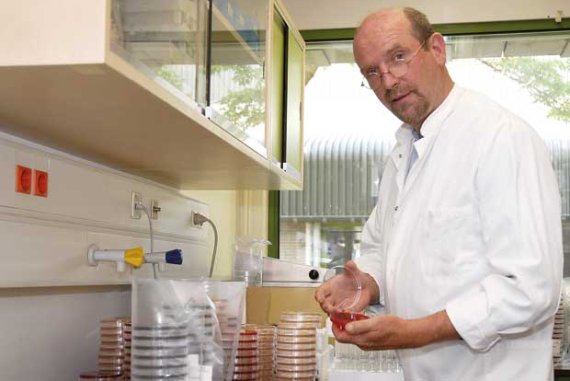Almost all chickens in the Netherlands are infected, as are many other farm animals. And five to ten per cent of Dutch people carry bacteria that produce ESBLs. These bacteria can now be found in vegetables, in wild migratory birds and in surface water. The problem is that some bacteria can produce Extended-Spectrum Beta-Lactamases (ESBLs), a group of enzymes that break down antibiotics. If a patient gets an ESBL-producing bacterium in the bloodstream, it becomes difficult – and in some cases impossible – to fight infections. That is why more research is needed on the bacteria that make ESBLs. The Central Veterinary Institute (CVI) will soon be starting a large-scale project to conduct a detailed survey of the spread of these bacteria. ‘Preventing such bacteria is much more of a problem than the media are suggesting,’ says CVI research manager Dik Mevius. ‘They mainly link it to meat but infected chickens are just a part of the problem. Our ecosystem is thoroughly contaminated.’ Is intensive livestock farming the source of the problem? ‘ESBLs have resulted from the use of antibiotics in both humans and animals. Antibiotics create the selection pressure. Intensive livestock farming certainly plays a part here. But then ESBL-producing bacteria are spread around the world via the complex trade routes for animals and the travel patterns of humans. We don’t know how exactly. ESBL bacteria are no longer confined to places where antibiotics are used. Organic livestock farms, which use hardly any antibiotics, also have ESBL-producing bacteria now.’ So reducing antibiotics use will no longer solve the problem? ‘The use of antibiotics in Dutch livestock farming has halved in only a few years, a fantastic achievement. That really does help because you need to eradicate the breeding grounds for new strains of ESBL bacteria. But you will only see an effect in the long term because ESBL bacteria are now widespread in livestock farming and the environment. We need to decide what level of infection should be our target, given that a level of zero is no longer feasible. And where do we need to intervene to prevent the spread of ESBL bacteria?’ How do you do that? ‘We will be investigating that now in our follow-up study. We will be performing a lot of measurements in places where ESBLs are found, we will be describing the bacterial strains and we will be developing models that describe how they spread from farms via abbatoirs to supermarkets. We hope this will show us where we need to intervene to reduce the spread of ESBLs. We are doing this in partnership with Utrecht University, the GD Animal Health Service, the National Institute for Public Health and the Environment and the private sector.’ The Agri&Food top sector is providing four million euros for the research.
Wide variety
More than one thousand different strains of ESBL bacteria have been found but the vast majority only turn up occasionally. There are ESBL bacteria that mainly occur in farm animals while other variants are primarily found in people. Only a few are found in both humans and animals.

